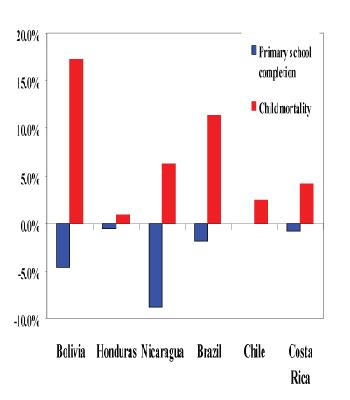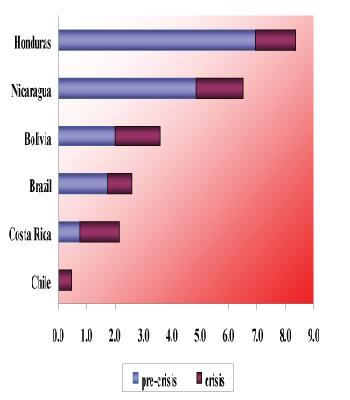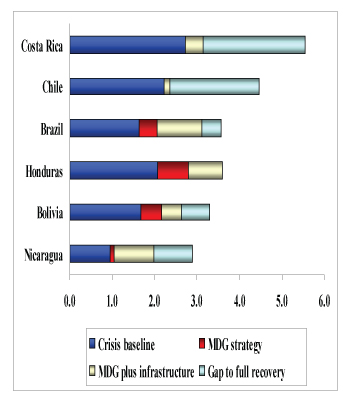Blog
The Impact of the Global Economic Crisis on the Millennium Development Goals in Latin America
Marco V. Sánchez and Rob Vos
Substantial slowdown in progress towards the Millennium Development Goals (MDGs) should be expected as a consequence of the global economic downturn. Even prior to the crisis and despite significant progress, many countries have not been on track to meet most MDGs (see The United Nations Millennium Development Goals Report 2009, published in New York by UN-DESA). Unless additional action is undertaken promptly, many countries are unlikely to meet the targets for reducing income poverty, child and maternal mortality and prevalence of major diseases, but also those for primary school completion, nutrition, and sanitation. Progress in several of these areas has also been deficient in most other regions, but especially in parts of south and western Asia, parts of Latin America and the Caribbean and the low income countries of the CIS. Until recently, robust income growth helped accelerate progress towards reducing income poverty in many countries, but the multiple crises of high food and energy prices and the global financial crisis that emerged in 2008 have created significant setbacks. Rising unemployment and underemployment, drops in per capita income and less government revenue will also affect both public and private spending and no doubt imply significant setbacks in the progress made towards the MDGs. The precise magnitude of the setback is difficult to estimate at this point and will vary from country to country according to existing fiscal policy space and institutional capacity to respond to the crisis.
This article is based on a new study by Sánchez and Vos at UN-DESA (see further reading) using a comprehensive modelling framework for six Latin American countries. The study finds that a projected recession in 2009 and 2010 followed by a slow and gradual recovery towards pre-crisis growth levels by 2015 would put some of the region’s low income countries (Bolivia, Honduras and Nicaragua) substantially further off track towards the goals for primary school completion, child and maternal mortality and access to drinking water and sanitation. In Bolivia, for instance, child mortality rates are projected to be more than 17 per cent higher by 2015 compared with a scenario of continued pre-crisis growth, while primary school completion rates would be about 5 per cent lower. Brazil, Chile and Costa Rica, that seemed well on track towards achieving most of the MDGs by 2015 under a continuation of spending and growth trends, would fall short of several of the targets because of the crisis (Figure 1).
Impact of the crisis on primary school completion and child mortality rates by 2015 in selected Latin American countries
(Percentage change)

Modelling MDG achievement
These findings are based on a quantitative analytical framework which allows assessment in some detail of the microeconomic determinants of MDG achievement considering country specific conditions and economy wide interaction effects. The framework facilitates the ex-ante analysis of the effectiveness of alternative policies for achieving the MDGs considering likely synergies among MDGs as well as macroeconomic trade offs. Investing in children’s nutritional status and health will likely result in better performance at school. This is an example of synergy. Governments with limited resources and wishing to prioritize spending on education and health services may find little fiscal revenue left for maintaining and investing in general physical infrastructure. The result could be that there is an improvement in education and health outcomes but at the cost of lower output growth and income poverty reduction. Poorly maintained road and transport infrastructure also could limit the accessibility of schools and health centres and thereby limit the effectiveness of public expenditures in these areas. If achieving the education and health goals implies hiring of additional teachers and health workers in large amounts, their wages, and with it the cost of the policy intervention, are likely to go up since such skills are not in unlimited supply. If, to finance the required increase in spending on education, health and basic sanitation, taxes will have to increase, this may also affect the disposable income of the poor and this then may indirectly affect the achievement of the MDGs. If financing involves more foreign aid or external borrowing, the real exchange rate might appreciate hurting output and employment in export sectors.
The framework was applied in a recent joint research project of UN-DESA, UNDP and the World Bank in 18 Latin American countries, but assuming pre-crisis economic conditions. In Sánchez and Vos we update these findings for the six countries indicated, considering the possible impact of the crisis. Next to the implications in terms of expected setback in MDG achievement, they also address the following additional questions: (i) How much more additional public spending would be needed to achieve the MDGs by 2015 as a consequence of the crisis? (ii) Will governments still be able to find sustainable funding for their MDG strategies? (iii) To what extent will increased MDG spending operate as an effective counter-cyclical response to economic recovery?
The crisis will substantially increase the costs of achieving the MDGs by 2015
To catch up, the governments of Bolivia, Honduras and Nicaragua would need to spend an extra 1.5 to 2.0 per cent of GDP per year on education, health and basic services between 2010 and 2015 in order to achieve the MDGs, as compared with the pre-crisis scenario (Figure 2).
Additional public spending for MDGs needed to achieve education, health and water and sanitation targets by 2015
(Percentage of GDP; average annual cost for 2010-2015)

This would come on top of an additional required annual social spending of 2 per cent of GDP in Bolivia, 5 per cent in Nicaragua and 7 per cent in Honduras in absence of the crisis. For Brazil, Chile and Costa Rica, the required additional spending caused by the expected impact of the crisis would be in the order of between 0.5 and 1.5 per cent of GDP per annum. Clearly, additional costs of this magnitude may stretch government finances, lead to unsustainable increases in public debt and become a source of macroeconomic instability in the future, if recovery and sustained growth do not set in swiftly.
MDG spending and economic recovery
Further analysis shows that increased social spending as part of the MDG strategy is counter-cyclical and would contribute to growth recovery, albeit not enough to return swiftly to pre-crisis levels of economic growth and employment (Figure 3). This is so because spending on MDG-related services represents relatively low shares of aggregate demand in these countries. Stronger growth effects likely will emerge over time, however, as improved education and health outcomes should be expected to underpin stronger productivity growth. Not surprisingly, the short-term counter-cyclical effects of the MDG strategy spending are strongest where the required increase in public spending is higher, as is the case in Bolivia and Honduras. The effect is surprisingly weaker in Nicaragua, where enhanced fiscal spending is causing stronger real exchange rate appreciation, such that the aggregate demand impulse is partially offset by a further weakening of exports. The counter-cyclical response becomes much stronger if the MDG strategy is complemented by much needed investments in public infrastructure in these countries as also shown in Figure 3. Yet, for all countries, it holds that other factors need to contribute as well for full recovery, especially the resumption of external demand is essential. Such a counter-cyclical response will need to come from globally concerted stimulus measures.
Simulated countercyclical impact of increased MDG spending on GDP growth, 2010-2015
(Average annual rate of growth in per cent)

Concluding Remarks
In all country cases it holds that careful macroeconomic management would be required to avoid undesirable growth costs elsewhere in the economy. The low income countries in the region likely will be unable to finance the increased costs without additional international support in the form of aid and/or debt relief to provide the additional fiscal space and avoid an insurmountable rise in external debt. In addition, some middle income countries may require some additional breathing space allowing them postponement of payment on some of their external debt obligations or affordable refinancing options to facilitate a gradual transition towards greater reliance on tax-financing of MDG-related social services. The upshot is that counter-cyclical macroeconomic policies can be feasibly aligned with long-term development objectives if carefully managed and supported by the international community.
WIDER Angle newsletter, August 2009
ISSN 1238-9544
 Join the network
Join the network